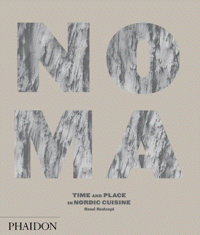If you are promoting seasonal, local, foraged ingredients for your Nordic cuisine – how does that translate to area of the world where few of the ingredients you use are available?
Cookbooks can introduce a particular way of thinking about recipes and cooking, a way of approaching ingredients, rather than a slavish devotion to recipes.
A cookbook isn’t necessarily written to cook from, and in one sense NOMA, Rene Redzepi‘s huge new cookbook from Phaidon isn’t. Just look at the structure of the book. More then half the book is devoted to stunning photographs by Ditte Isager. The book opens with essays on pastel colored paper about the restaurant and the chef, and only after all the photos do you come to The Weather Recipes themselves. At the end of the book is an important section, the Glossary with entries like Dulse “An edible seaweed, bright red, in colour. Also known as Sol” (p. 359). This is a treatise wrapped up in a beautiful cookbook on Rene Redzepi’s brand of Nordic cuisine.
 Pay attention to titles. This is geography of cooking, or geography of food. Taking the sense of foraged food to the extreme, while at the same time, extracting every bit of meaning he can from place. The book opens with more then one title: Noma, Nordisk Nordic Mad Food. Then Time and Place in Nordic Cuisine. There is a map showing Rene’s voyage to Greenland and Iceland, then the Faroe Islands and back to Denmark. It is a voyage of discovery that the book celebrates.
Pay attention to titles. This is geography of cooking, or geography of food. Taking the sense of foraged food to the extreme, while at the same time, extracting every bit of meaning he can from place. The book opens with more then one title: Noma, Nordisk Nordic Mad Food. Then Time and Place in Nordic Cuisine. There is a map showing Rene’s voyage to Greenland and Iceland, then the Faroe Islands and back to Denmark. It is a voyage of discovery that the book celebrates.
His diary captures that excitement and wonder of a taste that makes a food memory. Each new ingredient arouses ideas of how to cook with it, how to import it, how to capture the natural world where it is found:
At his home, we meet his wife Inga. She has cooked the most incredible turnips ever. Just dug up from the garden. Sweet, soft and moist. Almost taste like pears. Why? Is it because of the cold climate with long days and correspondingly more sun in summer? A huge discovery!
I get acquainted with havtorn (Hippophae rhamnoides or sea-buckthorn). A small yellow-opaque berry. Very, very sour. Tastes of exotic fruits. Wow! Would be good for syrup, sauces, aquavit, drying, savories and desserts. (p. 20)
Read this diary all the way through – it is key to the book and will help make sense of the stunning photographs: Fresh Cheese and Spruce Shoots (p. 51) or Musk Ox and Fresh Young Garlic, Milk Skin and Caramelized Garlic (p. 96). The dishes are interspersed with photos of the raw ingredients, just as chefs first study, taste, and analyze raw ingredients before inventing a dish. In the diary, Rene meets ceramic artists, stonemasons, and architects, and the objects these artists make are also among the photographs. They are essential to his idea of what Noma is.
The diary will help explain the subsequent recipes like Caramel and Malt (p. 257, which recalls the flavor of malt in a beer he drinks on Iceland, or Sea Buckthorn and Beetroot Flodeboller (p. 297).
What is the book, Noma. ? A statement about how to cook that is, in part, about cooking’s relationship to the natural world. It is a book of Art that is composed of ingredients that happen to be edible – or rather that are intentionally edible. It is a fascinating book.

“It is a book of Art that is composed of ingredients that happen to be edible” Yes! Thanks for this super review. I agree with everything you’ve said here, and have linked to your review from my blog.
If your readers are interested to learn more about Redzepi’s use of the Thermomix kitchen machine, feel free to view the Noma pages at
http://www.superkitchenmachine.com/?s=redzepi&submit=
cheers,
Helene